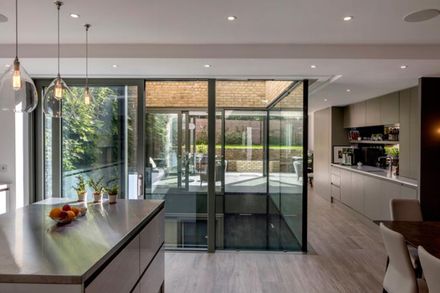
Cooperative Housing Scheme
COOPERATIVE HOUSING SCHEME
Peter Barber Architects + Mark Fairhurst Architects
ARCHITECTS
Peter Barber Architects, Mark Fairhurst Architects
AREA
1517.0 m2
CATEGORY
Apartments
LOCATION
4-8 Hafer Road London SW11, United Kingdom
PLANNING DESIGN
Peter Barber Architects
PHOTOGRAPHS
Morely von Sternberg
CONTRACTOR & DEVELOPER
Kuropatwa Ltd.
PHOTOGRAPHS
Morely von Sternberg
PARTY WALL SURVEYOR
GKR Associates
CDM COORDINATOR
Andrew Worsley
CONTRACTOR/DEVELOPER
Kuropatwa Ltd.
M&E ENGINEERS
Mandick Waring Consulting Engineers
PLANNING DESIGN
Peter Barber Architects
ACOUSTIC CONSULTANTS
KP Acoustics
CLIENT/DEVELOPER
On the Rise Housing Co-operative
ENERGY CONSULTANTS
Mandick Waring Consulting Engineers
MECHANICAL & ELECTRICAL ENGINEERS
Mandick Waring Consulting Engineers
STRUCTURAL ENGINEER
Hall Davis Consulting Engineers
LANDSCAPE ARCHITECT
Buckley Design Associates
MANUFACTURERS
Velfac, Alfresco, Aluprof, Domus Tiles, Kuropatwa Ltd Workshop, L&D Joinery, Sedum, The Safety Letterbox Company, Travis Perkins, Treebox, Wheeler, Wykamol
Text description provided by architect.
Mark Fairhurst Architects were appointed in 2014 by Kuropatwa Ltd. the developer/ contractor for the technical design of the 16 residential apartments at Hafer Road, we were challenged to deliver what was a relatively complex concept design by Peter Barber Architects.
Located in the London Borough of Wandsworth close to Clapham Common and Lavender Hill, 4-8 Hafer Road is a cooperative housing development replacing 8 existing flats on a former bomb damaged site with 4 maisonettes and a further 12 residential units.
A new basement provides accommodation for maisonettes naturally lit via two external courtyards to the rear and a continuous light well to the front spanned by entrance bridges to the maisonettes and communal entrances, two stair cores giving access to 8 flats above.
Flats are arranged with dual aspects with a combination of external terraces, projecting balconies and recessed terraces at roof level surmounted by a biodiverse brown roof with PV cells for renewable energy.
We developed the detailed design to ensure the successful realization of the scheme and to incorporate the different design requirements of the end users, more challenging than a conventional developer led scheme.
Various design enhancements were made to the glazing, internal layouts and finishes during the technical design stage.
The building was constructed in in-situ reinforced concrete frame with light gauge galvanised steel structural framing system for the external brick cavity wall support.
This allows substantial thermal insulation and flexibility in opening positions for various window types and concealing rainwater down pipes within the external wall construction so as not to disrupt the neatness of the façade and internal space.
The residents were keen to increase views and natural daylight to the rooms surrounding the courtyard.
External basement staircases, originally conceived as part of the bespoke fire strategy, were omitted and lobbies introduced at ground floor along with glazed screens to the living spaces.
The original courtyard glazing, designed as a matrix of smaller composite framed window panels, were replaced with a structural glazed curtain walling system allowing unobtrusive floor to ceiling glass complimented with full height sliding doors with glazed balustrades; the opening up of the courtyard allowing one owner to install a green wall with water feature.
Larger glazed panels were introduced to the rear gardens along with bi-parting sliding doors. A similar approach was taken to the design of the oriel windows with the opening sash relocated to the side panels to create a single sheet of glazing creating the ‘gold fish bowl’ effect.
Brick detailing was critical to the final appearance of the building this included integrating the differing window reveal depths. The brick balconies were altered during the original planning process due to the planners concern about the bulk of full brick balustrades facing the road therefore the front balustrades were revised to steel railings.
The high quality finish of the building was due to the contractor’s ability to offer a bespoke service to the residents allowing them to vary the internal finishes including the cabinets, tiling and sanitary wear.
Our collaborative relationship with the contractor and expertise as an RIBA Chartered Practice enabled us to understand the complexity of the planning design and detail sympathetically to the original design intent





















